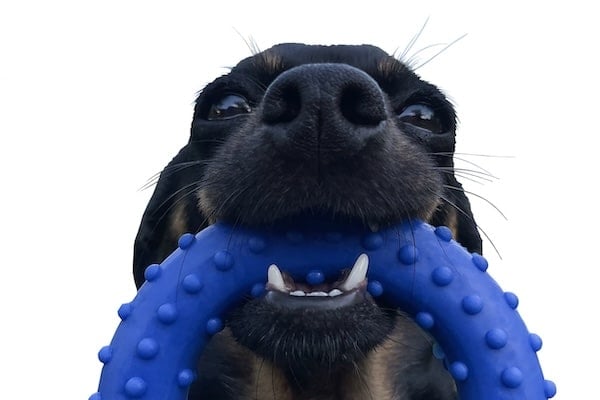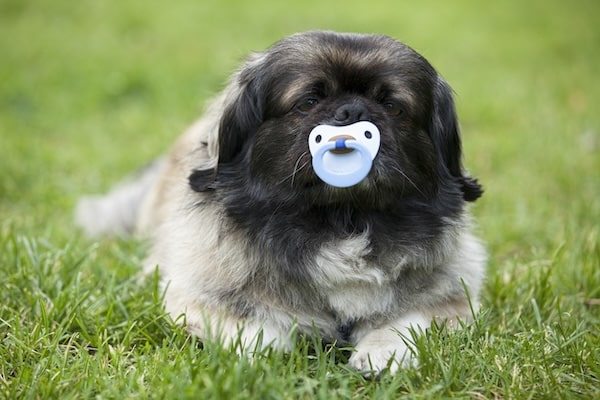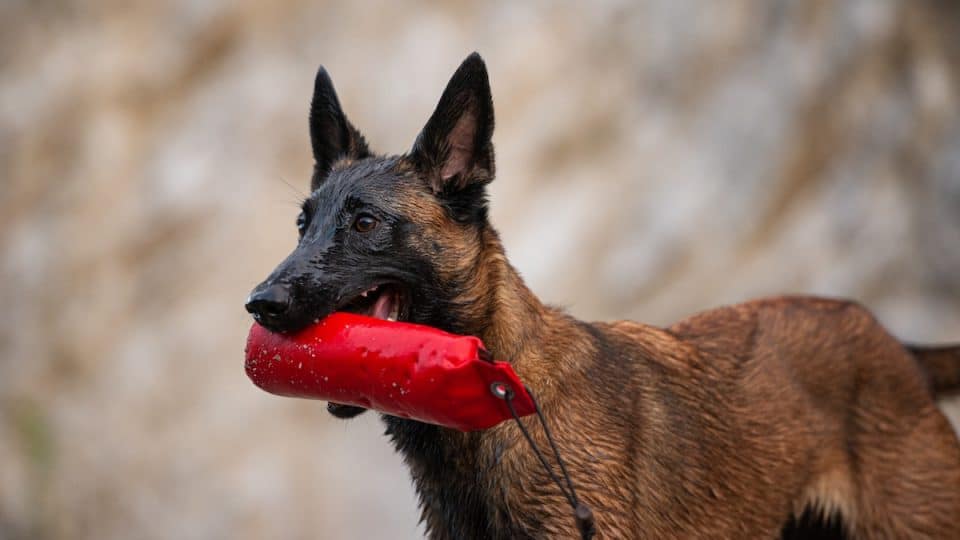- Not a substitute for professional veterinary help.
Want to teach your dog to hold something in their mouth? This trick, traditionally called “hold,” can be a little difficult to master, but if you’re patient and have established good communication with your dog, it’s definitely achievable.
Besides helping with fun photo ops, “hold” is a useful cue for service dogs (opening doors, holding keys or a phone) and for some sport dogs, like Retrievers, who hunt. It’s also good for agility games, dock diving, and scent work.
To give you a step-by-step guide, we’ve interviewed Qiai Chong, an animal behaviorist and certified fear-free trainer who specializes in animal welfare. She explains how to teach your dog to hold something in their mouth, along with other tricks that require “shaping,” or breaking a skill down into small movements.
Choosing the Right Object
When teaching your dog to hold, Ms. Chong recommends starting with a simple and safe object. Pet parents can transfer this skill to any safe object, but some objects will be easier than others while your dog learns.
- Soft rubber toys. Soft toys are designed for your dog’s mouth, and your dog may already be interested.
- Rolled up towels. Towels can be good objects if your dog is too distracted by a toy. Towels are soft on their mouth, have a texture that is desirable for some dogs, and are easy for your dog to hold.
- Foam balls. Like the towels, foam balls are soft and easy to hold—and your dog may already be interested, which can make training easier. Foam balls can also help your dog learn to hold something gently, which can be important if you intend to use this skill with a service dog.

Natalya Gavrilova via iStock
Step by Step
“Shaping” is a training concept that involves reinforcing small, incremental steps to achieve a desired behavior. Teaching “hold” usually means teaching several small moves—which is why Ms. Chong classifies it as an intermediate-to-advanced behavior.
If your dog has already learned targeting behaviors, like “touch” or “place,” they’ll likely have an easier time learning “hold.”
Step 1: Reward for looking
First, you’ll want to get your dog interested in the object. Set your object in front of your dog. When your dog looks at it, say “yes!” and reward them with a treat. Repeat this several times.
Step 2: Touch the object to your dog’s nose
Next, gently tap the object to your dog’s nose, quickly following the move with praise and a treat. Leave the object on the ground, and when your dog starts nosing it, say “yes!” and reward them with a treat.
Step 3: Progress to gripping the object in their mouth
Next, work toward getting your dog to grip the object in their mouth. Some dogs might jump to this behavior quickly when you stop rewarding for simple nose nudges, while others might need rewards for small intermediate steps, like opening their mouth as they nose the toy.
Step 4: Add a verbal cue
When your dog can grip the object reliably, start using a same verbal cue, like “hold” or “carry,” when they hold the object in their mouth. Always reward with praise and treats.
Step 5: Add duration
After your dog has mastered gripping the object with a verbal cue, you can begin to add the finesse that you are looking for. If you need your dog to hold something for a specific amount of time, for example, slowly increase the time between your cue and the reward.
Step 6: Release
Finally, start incorporating a verbal cue to signal to your dog that they can release the object, providing praise and rewards when they do.
Teaching Your Dog To Hold a Pacifier
Once your dog can recognize the verbal cue for “hold,” you can start changing up the objects you ask them to grip. Pacifiers are a silly and popular pick, since they lend themselves to photos (and are wildly popular on social media).
If you want to join in the trend, Ms. Chong recommends starting with a safe and simple object. Once your dog has mastered that, you can swap their ball or towel for a pacifier.
In order to get your photo, you’ll need your pup to hold the pacifier correctly. Start by handing it to your dog with the tip facing inward, then reward only when your dog holds it this way.
To add enough duration so you can get your picture, increase the amount of time you ask your dog to hold by just a few seconds every five or six repetitions, until they’re regularly holding the pacifier long enough for you to snap a pic.

TerryJ via iStock
Tips and Tricks
As Ms. Chong notes, “hold” can be a tricky skill to teach. It’s important to be patient and to make the training sessions interesting for your dog. Be sure to reward and praise your dog for exhibiting steps toward the desired “hold” behavior, even if they don’t get it right away. If you notice that your dog is getting frustrated, pause training and engage with something else that your dog enjoys.
Try food
If your dog is struggling, try using a different object. Sometimes, if a dog already knows the “wait” cue, pet parents can use food as the training object. To try this, use the established verbal cue, have your dog hold the food in their mouth, and then say “wait.” You can even try using the established “release” cue before rewarding your dog with the treat.
Try clicker training
If you already use a clicker in your training, you can try the technique with “hold” as well. This helps to establish precision; your dog will know the precise time that they did what was being asked. Ms. Chong notes that for pet parents who want to use “hold” to support a photo op, precision can be key to getting your dog to hold and sit nicely for the shot.
Slow down
If your dog is struggling, try to spend more time on each specific shaping skill, and allow time to pass before adding the next step. You may be able to only work on one aspect of the skill each day and slowly piece together the steps.
Benefits To Teaching Your Dog to Hold
“Hold” can be a useful cue for a lot more than a cute photo session. It’s a common skill for service dogs, who may need to hold keys, hold or answer a phone, or retrieve a needed object. It can also be a useful skill for everyday activities, like holding a leash.
Asking your dog to “hold” is also a great way to redirect their attention. If you have a dog who is easily excited when guests come over or when they see another dog out and about, asking them to hold their object can help pet parents to get their dog to focus on something else and limit an undesired behavior. That goes for other impulses like chasing a cat, begging, or jumping on furniture.
Plus, teaching “hold” is fun—working with your dog to achieve an advanced skill is a great way to bond. And the shaping skills you develop can make it easier to teach all kinds of other skills too. Your dog will gain confidence and skills—and so will you.



